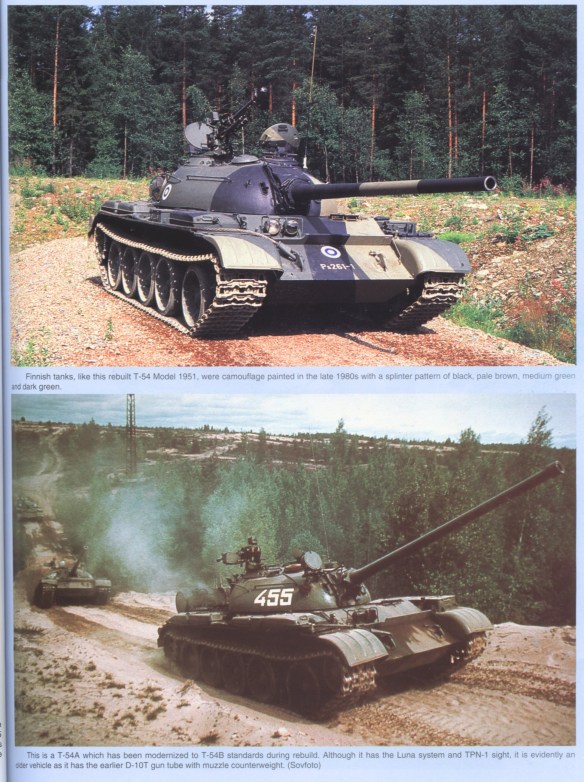The first postwar Soviet MBT, introduced in 1948, was the formidable T-54, itself a refinement of the T-44, the short-lived redesign of the T- 34/85 at the end of World War II. The T-54 had improved mechanical ability, especially in its torsion-bar suspension and transmission. It had five road wheels per side, with a noticeable gap between the first and second road wheels. There were no return rollers. The original turret design tended to deflect rounds downward into the turret ring and was replaced by a more hemispherical “frying pan” shape with internal mantlet.
The T-54 had a longer hull than the T-44, as well as a larger and better-shaped turret. It also had improved tracks, a torsion-bar suspension system, and a transverse-mount engine at the hull rear. The T-54 weighed some 79,300 pounds, had a crew of four, and a 520- hp diesel engine giving a maximum road speed of 30 mph. It mounted a 100mm main gun and three machine guns. The bow machine gun, done away with on the T-44, resurfaced in the T-54, but without return of the crewman for it; manning the bow gun was now the responsibility of the driver. The T-54 had maximum 203mm armor protection.
In the mid-1950s the T-54 received a bore evacuator near the muzzle of the main gun, which was also stabilized for elevation. The T-54B of 1957–1958 introduced a stabilized gun for both elevation and traverse. It also had infrared driving lights and snorkel equipment enabling it to cross rivers while submerged.
The T-55 appeared beginning in 1958. The chief difference between it and the T-54 was in the latter’s more powerful V-55 580-hp diesel engine. It also had a slightly modified turret, an improved 100mm main gun, a better transmission, a revolving turret floor (meaning that the crew did not have to shift position as the turret rotated), and increased ammunition storage. In 1963 the T-55 received an NBC system. The bow machine gun was also eliminated. In the late 1980s the T-55s received new supercharged engines, improved fire-control and laser-range finding systems, and appliqué and explosive armor.
The T-54/T-55 had a very long service life. Production continued until 1981, with a phenomenal 95,000 tanks manufactured, more than any other tank in history. Both the Chinese and Romanians have produced copies. Even at the end of the Cold War the T-54/T- 55 constituted some 38 percent of overall Soviet tank strength and as much as 86 percent of non-Soviet Warsaw Pact armor. Reliable and relatively inexpensive, the T-54/T-55 was exported to more than 35 other nations (outside of the Warsaw Pact these included Egypt, Finland, India, Iraq, Libya, and Syria). Although obsolescent, these tanks nonetheless remain in service today. Egypt has upgraded its T- 55s with U.S. engines, guns, and fire-control systems. Israel captured a number of T-54/T-55s from Egypt and Syria and proceeded to upgrade them with General Motors engines and 105mm M68 guns.
The T-54/T-55s have had a mixed combat record. Although sufficient to crush the Hungarian Revolution of 1956, they were not successful against Western-supplied Israeli armor in the 1967 Six Day War. They continued as the mainstay of Egyptian as well as Syrian armor in the 1973 Yom Kippur War, and although these tanks inflicted losses on Israeli tanks in that conflict, the Arab armies were again defeated. This was more a failure of doctrine and training than of equipment, however. The T-55 continued to serve in Africa, Asia, Afghanistan, and in Iraq. They were easily outclassed by the Coalition’s armor in the 1991 Gulf War.
Summary: A further development of the mechanically unreliable T-44, itself derived from the T-34. The chief difference between the T-54 and T-55 is a more powerful diesel engine. With the largest production run of any tank in history, the T-54/T-55, even at the end of the Cold War, constituted 38 percent of the Soviet tank inventory and about 85 percent of the non-Soviet Warsaw Pact inventory. The T-54/T-55 has been exported to more than 35 different nations, and although obsolescent today, it remains in widespread use.
Production dates: 1948–1981
Number produced: Approx. 95,000
Manufacturer: Soviet state factories
Crew: 4 (the bow gun reappeared but not the bow gunner; handling it is the responsibility of the driver)
Armament: 1 x 100mm main gun; 1 x 12.7mm DShK machine gun (antiaircraft); 2 x 7.62mm machine guns (bow, coaxial)
Weight: 79,344 lbs.
Length (excluding gun): 21’2”
Width: 10’9”
Height: 7’10”
Armor: maximum 203mm (steel)
Ammunition storage and type: 34 x 100mm; 500 x 12.7mm; 3,000 x 7.62mm
Power plant: V-2-5412-cylinder 520-hp diesel engine (T-54); V-55 580-hp diesel engine (T-55)
Maximum speed: 30 mph (T-54); 31 mph (T-55)
Range: 250 miles
Fording depth: 4’7”
Vertical obstacle: 2’7”
Trench crossing: 8’10”
Special characteristics (positive/negative): Can be equipped with snorkel device to allow submerged fording. Long-range fuel tanks extend mileage to 450 miles. T- 55A added infrared NBC system. In the late 1980s T-55s received new supercharged V-55U engines, improved fire-control system, laser rangefinders, and appliqué and explosive armor. Special models: many, including recovery vehicles; engineer vehicles; bridge-layers; mine-clearers
